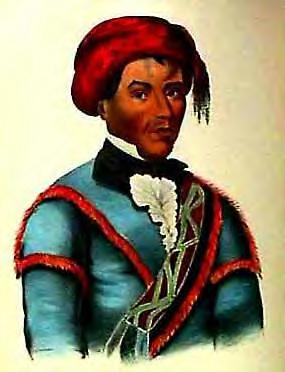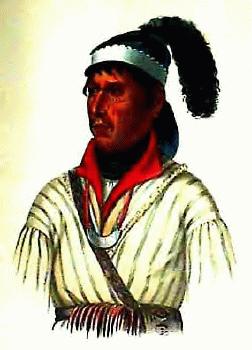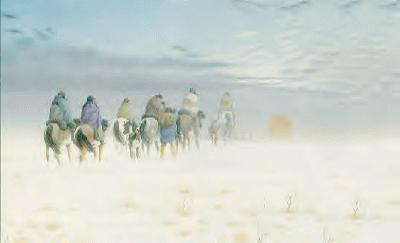|
|
|
|
This Date in History
Adapted by Vicki Lockard from This Date in History
| April 9, 1682: | Today, the expedition of French and Indians under la Salle will reach the mouth of the Mississippi River, based on his expedition along the Mississippi from its juncture with the Illinois River, la Salle will claim the Mississippi valley, and what would become Louisiana, for the French. |
| April 10, 1830: | The first wagons appear on the Oregon Trail. |
| April 11, 1968: | The American Indian Civil Rights Act is passed. |
| April 12, 1886: | Due to General Crook making an agreement with Geronimo about his surrender terms which his supervisors would not honor, Geronimo does not surrender. This angers Washington, and Crook is replaced on this date by Nelson "Bear Coat" Miles. Miles will eventually take a large force into the field to hunt down Geronimo and his 24 holdouts. |

"Geronimo and Chief Joseph"-Edward S.Curtis
| April 13,1946: | Congress will create the Indian Claims Commission today. The commission is established to hear and decide claims made by Indians based on land losses from treaties. |
| April 14,1877: | Expecting to be given a reservation in the Powder River area, and to avoid General George "Three Stars" Crook, Touch The Clouds, and many MINNECONJOs and SANS ARCs surrender at the Spotted Tail Agency in Nebraska. Although many of these people are from Crazy Horse's village, Crazy Horse will not surrender for a few weeks more. |
| April 15,1873: | The Indian peace policy is explained in an open letter from Secretary Delano to L.L.Crounse. It have five major provisions: 1. Put the Indians on reservations as soon as possible, where they can be provided for; 2. Punish Indians who are unwilling to go onto the reservations, and who fight, until they are willing to go, and live peacefully; 3. Furnish supplies at fair prices; 4. Appoint "competent, upright, moral, and religious" agents; 5. Establish regular schools, and Sunday schools, so Indians can become citizens. |
| April 16, 1813: | Today, CREEK leaders, including Tustunnuggee Thlucco, and local Europeans will finish executing members of the Red Sticks faction believed to be involved in the unprovoked murders of European settlers. Between April 16th and today they will have executed 11 CREEKs. The Red Sticks have been motivated by the teachings of Tecumseh. |

Tustunnuggee Thlucco
| April 17, 1528: | Panfilo de Narvaez will begin his exploration of Florida by coming ashore near Tampa Bay. He will visit an Indian house which is big enough to hold 300 people, in his opinion. He will also find a "rattle" made of gold in the abandoned house. The discovery of gold will spur Narvaez onward across Florida. |
| April 18, 1879: | After the Custer disaster, the U.S.government decided to punish the plains Indians. While the PONCAs had no part in the Custer battle, the had erroneously been placed in a reservation with the SIOUX. When it was decided to force the SIOUX to go to Indian Territory (Oklahoma), the PONCAs were ordered to go as well. Many PONCAs started to walk back to their old reservation from Indian Territory. Eventually, General Crook would sympathize with the PONCAs and one of their Chiefs, Standing Bear. Seeking public support to avoid being ordered to sending Standing Bear back to Indian Territory, General Crook contacted the press about the PONCAs' plight. Many editorials were written in support of the PONCAs, and several lawyers volunteered their services for free. Judge Elmer Dundy, with Crook's blessing, issued a writ of habeas corpus to the General to produce the PONCAs and show why he held them. A U.S. District Attorney argued that the PONCAs could not be served a writ because they had no legal standing , or were not recognized as people, under the law. On this date the tribe began to determine if Indians, and particularly Standing Bear, were people under U.S. laws and could enjoy constitutional rights and privileges. The judge would eventually rule that Standing Bear was indeed a person and could not be ordered to a reservation against his will. While this decision would seem to prevent keeping any Indians on any particular reservation against their will, the eventual course of the U.S. Government was to say the ruling applied only to Standing Bear, and to no one else. |
| April 19,1842: | Mikasuki SEMINOLE Hallack Tustenuggee is Chief of one of the last groups of SEMINOLEs still fighting American forces. Today, his band will engage 400 soldiers, under Colonel William Worth, near Lake Ahapopka, Florida. Leaving their provisions behind, many of the SEMINOLEs will escape. Many historians will consider this to be the last battle of the Second SEMINOLE War. |

Hallack Tustenuggee
| April 20,1606: | According to the first charter of Virginia, issued today, part of the colonists goals are to civilize the natives. "... and may in time bring the infidels and savages, living in those parts, to human civility." |
| April 21,1869: | Donehogawa (Ely Samuel Parker) is appointed as the first Indian to be Commissioner of Indian Affairs. Donehogawa, a SENECA IROQUOIS, was trained as a lawyer and a civil engineer. Unable to find work in the white world, Donehogawa contacts his old friend Ulysses Grant. Grant makes him an aide, and they work together through much of the Civil War. Because of his excellent penmanship, Donehogawa draws up the surrender papers for Lee to sign at Appomattox. Promoted to Brigadier General, Ely Parker worked to settle many conflicts between whites and Indians. After Grant becomes President, he will be appointed as Indian Commissioner on this date. |
| April 22,1877: | Two Moons, Hump, and 300 other Indians surrender to Col. Nelson Miles, today. Most of the rest of Crazy Horse's followers will surrender on May 6, 1877 at the Red Cloud, and Spotted Tail agencies. |

"Moving West" Donald Vann
|
|
| Canku Ota is a free Newsletter celebrating Native America, its traditions and accomplishments . We do not provide subscriber or visitor names to anyone. Some articles presented in Canku Ota may contain copyright material. We have received appropriate permissions for republishing any articles. Material appearing here is distributed without profit or monetary gain to those who have expressed an interest. This is in accordance with Title 17 U.S.C. section 107. |
|
Canku Ota is a copyright of Vicki Lockard and Paul Barry. |
|